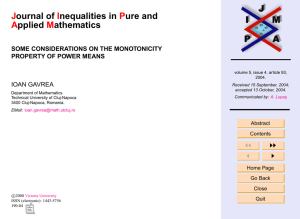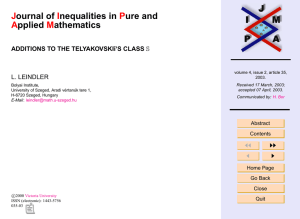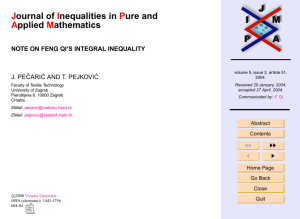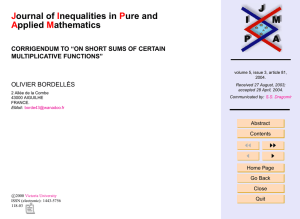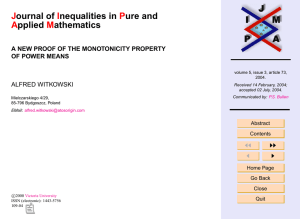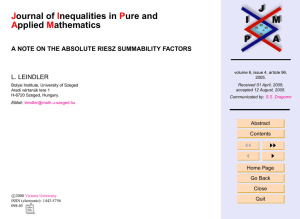J I P A
advertisement
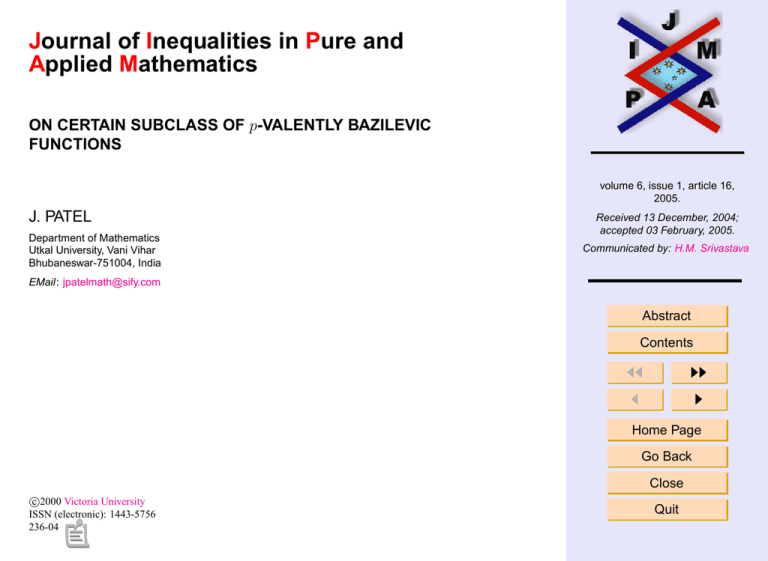
Journal of Inequalities in Pure and
Applied Mathematics
ON CERTAIN SUBCLASS OF p-VALENTLY BAZILEVIC
FUNCTIONS
volume 6, issue 1, article 16,
2005.
J. PATEL
Department of Mathematics
Utkal University, Vani Vihar
Bhubaneswar-751004, India
Received 13 December, 2004;
accepted 03 February, 2005.
Communicated by: H.M. Srivastava
EMail: jpatelmath@sify.com
Abstract
Contents
JJ
J
II
I
Home Page
Go Back
Close
c
2000
Victoria University
ISSN (electronic): 1443-5756
236-04
Quit
Abstract
We introduce a subclass Mp (λ, µ, A, B) of p-valent analytic functions and derive certain properties of functions belonging to this class by using the techniques of Briot-Bouquet differential subordination. Further, the integral preserving properties of Bazilevic functions in a sector are also considered.
On Certain Subclass of
p-Valently Bazilevic Functions
2000 Mathematics Subject Classification: 30C45.
Key words: p-valent; Bazilevic function; Differential subordination.
J. Patel
The work has been supported by the financial assistance received under DRS programme from UGC, New Delhi.
Title Page
Contents
1
Introduction . . . . . . . . . . . . . . . . . . . . . . . . . . . . . . . . . . . . . . . . .
2
Preliminaries . . . . . . . . . . . . . . . . . . . . . . . . . . . . . . . . . . . . . . . .
3
Main Results . . . . . . . . . . . . . . . . . . . . . . . . . . . . . . . . . . . . . . . .
References
Contents
3
6
9
JJ
J
II
I
Go Back
Close
Quit
Page 2 of 28
J. Ineq. Pure and Appl. Math. 6(1) Art. 16, 2005
http://jipam.vu.edu.au
1.
Introduction
Let Ap be the class of functions of the form
(1.1)
p
f (z) = z +
∞
X
an z n
(p ∈ N = {1, 2, 3, . . . })
n=p+1
which are analytic in the open unit disk E = {z ∈ C : |z| < 1}. We denote
A1 = A.
A function f ∈ Ap is said to be in the class Sp∗ (α) of p-valently starlike of
order α, if it satisfies
0 zf (z)
> α (0 ≤ α < p; z ∈ E).
(1.2)
<
f (z)
We write Sp∗ (0) = Sp∗ , the class of p-valently starlike functions in E.
A function f ∈ Ap is said to be in the class Kp (α) of p-valently convex of
order α, if it satisfies
00
zf (z)
(1.3)
< 1+ 0
> α (0 ≤ α < p; z ∈ E).
f (z)
The class of p-valently convex functions in E is denoted by Kp . It follows from
(1.2) and (1.3) that
f ∈ Kp (α) ⇐⇒ f ∈ Sp∗ (α)
(0 ≤ α < p).
On Certain Subclass of
p-Valently Bazilevic Functions
J. Patel
Title Page
Contents
JJ
J
II
I
Go Back
Close
Quit
Page 3 of 28
J. Ineq. Pure and Appl. Math. 6(1) Art. 16, 2005
http://jipam.vu.edu.au
Furthermore, a function f ∈ Ap is said to be p-valently Bazilevic of type µ
and order α, if there exists a function g ∈ Sp∗ such that
<
(1.4)
0
zf (z)
f (z)1−µ g(z)µ
>α
(z ∈ E)
for some µ(µ ≥ 0) and α(0 ≤ α < p). We denote by Bp (µ, α), the subclass
of Ap consisting of all such functions. In particular, a function in Bp (1, α) =
Bp (α) is said to be p-valently close-to-convex of order α in E.
For given arbitrary real numbers A and B (−1 ≤ B < A ≤ 1), let
0
1 + Az
zf (z)
∗
(1.5)
Sp (A, B) = f ∈ Ap :
≺p
, z∈E ,
f (z)
1 + Bz
where
the symbol
≺ stands for subordination. In particular, we note that
2α
∗
Sp 1 − p , −1 = Sp∗ (α) is the class of p-valently starlike functions of order α(0 ≤ α < p). From (1.5), we observe that f ∈ Sp∗ (A, B), if and only if
(1.6)
0
zf (z) p(1 − AB) p(A − B)
f (z) − 1 − B 2 < 1 − B 2
J. Patel
Title Page
Contents
JJ
J
II
I
Go Back
(−1 < B < A ≤ 1; z ∈ E)
Close
Quit
and
(1.7)
On Certain Subclass of
p-Valently Bazilevic Functions
<
0
zf (z)
f (z)
p(1 − A)
>
2
Page 4 of 28
(B = −1; z ∈ E).
J. Ineq. Pure and Appl. Math. 6(1) Art. 16, 2005
http://jipam.vu.edu.au
Let Mp (λ, µ, A, B) denote the class of functions in Ap satisfying the condition
0
zf (z)
(1.8)
f (z)1−µ g(z)µ
00
0
0
zf (z)
zf (z)
zg (z)
1 + Az
+λ 1+ 0
− (1 − µ)
−µ
≺p
f (z)
f (z)
g(z)
1 + Bz
(−1 ≤ B < A ≤ 1; z ∈ E)
for some real µ(µ ≥ 0), λ(λ > 0), and g ∈ Sp∗ . For convenience, we write
2α
Mp λ, µ, 1 −
, −1
p
= Mp (λ, µ, α)
0
zf (z)
= f ∈ Ap : <
f (z)1−µ g(z)µ
0
0
00
zf (z)
zf (z)
zg (z)
+λ 1 + 0
− (1 − µ)
−µ
>α
f (z)
f (z)
g(z)
for some α (0 ≤ α < p) and z ∈ E.
In the present paper, we derive various useful properties and characteristics
of the class Mp (λ, µ, A, B) by employing techniques involving Briot-Bouquet
differential subordination. The integral preserving properties of Bazilevic functions in a sector are also considered. Relevant connections of the results presented here with those obtained in earlier works are pointed out.
On Certain Subclass of
p-Valently Bazilevic Functions
J. Patel
Title Page
Contents
JJ
J
II
I
Go Back
Close
Quit
Page 5 of 28
J. Ineq. Pure and Appl. Math. 6(1) Art. 16, 2005
http://jipam.vu.edu.au
2.
Preliminaries
To establish our main results, we shall require the following lemmas.
Lemma 2.1 ([6]). Let h be a convex function in E and let ω be analytic in E
with <{ω(z)} ≥ 0. If q is analytic in E and q(0) = h(0), then
0
q(z) + ω(z) zq (z) ≺ h(z)
(z ∈ E)
implies
q(z) ≺ h(z)
On Certain Subclass of
p-Valently Bazilevic Functions
(z ∈ E).
Lemma 2.2. If −1 ≤ B < A ≤ 1, β > 0 and the complex number γ satisfies
<(γ) ≥ −β(1 − A)/(1 − B), then the differential equation
0
zq (z)
1 + Az
q(z) +
=
β q(z) + γ
1 + Bz
Title Page
(z ∈ E)
has a univalent solution in E given by
z β+γ (1 + Bz)β(A−B)/B
γ
R
−
z
β tβ+γ−1 (1 + Bt)β(A−B)/B dt β ,
0
(2.1)
q(z) =
z β+γ exp(β Az)
γ
R
β z tβ+γ−1 exp(β At)dt − β ,
0
If φ(z) = 1 + c1 z + c2 z 2 + · · · is analytic in E and satisfies
J. Patel
Contents
B 6= 0
JJ
J
II
I
Go Back
B = 0.
Close
Quit
Page 6 of 28
0
(2.2)
z φ (z)
1 + Az
φ(z) +
≺
βφ(z) + γ
1 + Bz
(z ∈ E),
J. Ineq. Pure and Appl. Math. 6(1) Art. 16, 2005
http://jipam.vu.edu.au
then
φ(z) ≺ q(z) ≺
1 + Az
1 + Bz
(z ∈ E)
and q(z) is the best dominant of (2.2).
The above lemma is due to Miller and Mocanu [7].
Lemma 2.3 ([12]). Let ν be a positive measure on [0, 1]. Let h be a complexvalued function defined on E × [0, 1] such that h(·, t) is analytic in E for each
t ∈ [0, 1], and h(z, ·) is ν-integrable on [0, 1] for all z ∈ E. In addition, suppose
that <{h(z, t)} > 0, h(−r, t) isR real and <{1/h(z, t)} ≥ 1/h(−r, t) for |z| ≤
1
r < 1 and t ∈ [0, 1]. If h(z) = 0 h(z, t) dν(t), then <{1/h(z)} ≥ 1/h(−r).
For real or complex numbers a, b, c (c 6= 0, −1, −2, . . . ), the hypergeometric
function is defined by
(2.3)
2 F1 (a, b; c; z) = 1 +
a·b z
a(a + 1) · b(b + 1) z 2
· +
·
+ ··· .
c
1!
c(c + 1)
2!
We note that the series in (2.3) converges absolutely for z ∈ E and hence
represents an analytic function in E. Each of the identities (asserted by Lemma
2.3 below) is well-known [13].
Lemma 2.4. For real numbers a, b, c (c 6= 0, −1, −2, . . . ), we have
Z 1
(2.4)
tb−1 (1 − t)c−b−1 (1 − tz)−a dt
On Certain Subclass of
p-Valently Bazilevic Functions
J. Patel
Title Page
Contents
JJ
J
II
I
Go Back
Close
Quit
Page 7 of 28
0
=
Γ(b)Γ(c − b)
2 F1 (a, b; c; z)
Γ(c)
(c > b > 0)
J. Ineq. Pure and Appl. Math. 6(1) Art. 16, 2005
http://jipam.vu.edu.au
(2.5)
(2.6)
2 F1 (a, b; c; z)
2 F1 (a, b; c; z)
= 2 F1 (b, a; c; z)
−a
= (1 − z)
2 F1
z
a, c − b; c;
z−1
.
Lemma 2.5 ([10]). Let p(z) = 1 + c1 z + c2 z 2 + · · · be analytic in E and
p(z) 6= 0 in E. If there exists a point z0 ∈ E such that
(2.7) | arg p(z)| <
π
η (|z| < |z0 |) and
2
| arg p(z0 )| =
π
η (0 < η ≤ 1),
2
then we have
On Certain Subclass of
p-Valently Bazilevic Functions
J. Patel
0
z0 p (z0 )
= ikη,
p(z0 )
(2.8)
where
(2.9)
Title Page
Contents
k ≥
1
2
x+
1
x
k ≤ − 12 x +
,
1
x
when arg p(z0 ) = π2 η,
,
when arg p(z0 ) = − π2 η,
JJ
J
II
I
Go Back
and
(2.10)
Close
1/η
p(z0 )
= ±ix (x > 0).
Quit
Page 8 of 28
J. Ineq. Pure and Appl. Math. 6(1) Art. 16, 2005
http://jipam.vu.edu.au
3.
Main Results
Theorem 3.1. Let −1 ≤ B < A ≤ 1, λ > 0 and µ ≥ 0. If f ∈ Mp (λ, µ, A, B),
then
0
(3.1)
zf (z)
λ
≺
= q(z)
1−µ
µ
p f (z) g(z)
p Q(z)
(z ∈ E),
where
(3.2)
Q(z) =
R p
01 s λ −1
1+Bsz
1+Bz
p(A−B)
λB
ds,
On Certain Subclass of
p-Valently Bazilevic Functions
B 6= 0,
J. Patel
R 1 s λp −1 exp
0
p
(s
λ
− 1)Az ds,
B = 0,
Title Page
1
λB
q(z) =
when A = −
, B 6= 0,
1 + Bz
p
Contents
and q(z) is the best dominant of (3.1). Furthermore, if A ≤ −λ B/p with
−1 ≤ B < 0, then
(3.3)
Mp (λ, µ, A, B) ⊂ Bp (µ, ρ),
JJ
J
II
I
Go Back
Close
where
ρ = ρ(p, λ, A, B) = p
The result is best possible.
2 F1
p(B − A) p
B
1,
; + 1;
λB
λ
B−1
Quit
−1
.
Page 9 of 28
J. Ineq. Pure and Appl. Math. 6(1) Art. 16, 2005
http://jipam.vu.edu.au
Proof. Defining the function φ(z) by
0
(3.4)
zf (z)
φ(z) =
p f (z)1−µ g(z)µ
(z ∈ E),
we note that φ(z) = 1+c1 z +c2 z 2 +· · · is analytic in E. Taking the logarithmic
differentiations in both sides of (3.4), we have
0
00
0
0
zf (z)
zf (z)
zf (z)
zg (z)
(3.5)
+λ 1+ 0
− (1 − µ)
−µ
f (z)1−µ g(z)µ
f (z)
f (z)
g(z)
0
zφ (z)
p(1 + Az)
= p φ(z) + λ
≺
(z ∈ E).
φ(z)
1 + Bz
Thus, φ(z) satisfies the differential subordination (2.2) and hence by using
Lemma 2.2, we get
φ(z) ≺ q(z) ≺
1 + Az
1 + Bz
(z ∈ E),
where q(z) is given by (2.1) for β = p/λ and γ = 0, and is the best dominant
of (3.5). This proves the assertion (3.1).
Next, we show that
(3.6)
inf <(q(z)) = q(−1).
|z|<1
If we set a = p(B − A)/λB, b = p/λ, c = (p/λ) + 1, then c > b > 0. From
On Certain Subclass of
p-Valently Bazilevic Functions
J. Patel
Title Page
Contents
JJ
J
II
I
Go Back
Close
Quit
Page 10 of 28
J. Ineq. Pure and Appl. Math. 6(1) Art. 16, 2005
http://jipam.vu.edu.au
(3.2), by using (2.4), (2.5) and (2.6), we see that for B 6= 0
Z 1
a
(3.7)
Q(z) = (1 + Bz)
sb−1 (1 + Bsz)−a ds
0
Γ(b)
Bz
=
.
2 F1 1, a; c;
Γ(c)
Bz + 1
To prove (3.6), we need to show that <{1/Q(z)} ≥ 1/Q(−1), z ∈ E. Since
A < −λ B/p implies c > a > 0, by using (2.4), (3.7) yields
Z 1
Q(z) =
h(z, s) dν(s),
On Certain Subclass of
p-Valently Bazilevic Functions
J. Patel
0
where
1 + Bz
(0 ≤ s ≤ 1) and
1 + (1 − s)Bz
Γ(b)
sa−1 (1 − s)c−a−1 ds
dν(s) =
Γ(a)Γ(c − a)
h(z, s) =
which is a positive measure on [0, 1]. For −1 ≤ B < 0, it may be noted that
<{h(z, s)} > 0, h(−r, s) is real for 0 ≤ r < 1, 0 ∈ [0, 1] and
1
1 + (1 − s)Bz
1 − (1 − s)Br
1
<
=<
≥
=
h(z, s)
1 + Bz
1 − Br
h(−r, s)
for |z| ≤ r < 1 and s ∈ [0, 1]. Therefore, by using Lemma 2.3, we have
1
1
<
≥
, |z| ≤ r < 1
Q(z)
Q(−r)
Title Page
Contents
JJ
J
II
I
Go Back
Close
Quit
Page 11 of 28
J. Ineq. Pure and Appl. Math. 6(1) Art. 16, 2005
http://jipam.vu.edu.au
and by letting r → 1− , we obtain < 1/Q(z) ≥ 1/Q(−1). Further, by taking
A → (−λ B/p)+ for the case A = (−λ B/p), and using (3.1), we get (3.3).
The result is best possible as the function q(z) is the best dominant of (3.1).
This completes the proof of Theorem 3.1.
Setting µ = 1, A = 1 − (2α/p) (p − λ)/2 ≤ α < p and B = −1 in
Theorem 3.1, we have
Corollary 3.2. If f ∈ Ap satisfies
0
00
0
zf (z)
zf (z) zg (z)
<
+λ 1+ 0
−
>α
g(z)
f (z)
g(z)
(λ > 0, z ∈ E)
J. Patel
for some g ∈ Sp∗ , then f ∈ Bp (κ(p, λ, α)), where
−1
1
2(p − α) p
.
; + 1;
(3.8)
κ(p, λ, α) = p 2 F1 1,
λ
λ
2
The result is best possible.
Taking µ = 0, A = 1 − (2α/p) (p − λ)/2 ≤ α < p and B = −1 in
Theorem 3.1, we get
Corollary 3.3. If f ∈ Ap satisfies
00
0
zf (z)
zf (z)
< (1 − λ)
+λ 1+ 0
>α
f (z)
f (z)
On Certain Subclass of
p-Valently Bazilevic Functions
Title Page
Contents
JJ
J
II
I
Go Back
Close
Quit
(λ > 0, z ∈ E)
then f ∈ Sp∗ (κ(p, λ, α)), where κ(p, λ, α) is given by (3.8). The result is best
possible.
Page 12 of 28
J. Ineq. Pure and Appl. Math. 6(1) Art. 16, 2005
http://jipam.vu.edu.au
Putting λ = 1 in Corollary 3.3, we get
Corollary 3.4. For (p − 1)/2 ≤ α < p, we have
Kp (α) ⊂ Sp∗ (κ(p, α)),
where κ(p, α) = p {2 F1 (1, 2(p − α); p + 1; 1/2)}−1 . The result is best possible.
Remark 1.
1. Noting that
2 F1
1
1, 2(1 − α); 2;
2
−1
=
22(1−α)1−2α
,
(1−22α−1 )
1
,
2 ln 2
α 6=
1
2
J. Patel
α = 12 ,
Corollary 3.4 yields the corresponding result due to MacGregor [5] (see
also [12]) for p = 1.
2. It is proved [9] that if p ≥ 2 and f ∈ Kp , then f is p-valently starlike in
E but is not necessarily p-valently starlike of order larger than zero in E.
However, our Corollary 3.4 shows that if f is p-valently convex of order at
least (p − 1)/2, then f is p-valently starlike of order larger than zero in E.
Theorem 3.5. If f ∈ Bp (µ, α) for some µ (µ > 0), α (0 ≤ α < p), then
f ∈ Mp (λ, µ, α) for |z| < R(p, λ, α), where λ > 0 and
√
2
(p+λ−α)− (p+λ−α) −p(p−2α) , α 6= p ;
p−2α
2
(3.9)
R(p, λ, α) =
p ,
α = p2 .
p+2λ
The bound R(p, λ, α) is best possible.
On Certain Subclass of
p-Valently Bazilevic Functions
Title Page
Contents
JJ
J
II
I
Go Back
Close
Quit
Page 13 of 28
J. Ineq. Pure and Appl. Math. 6(1) Art. 16, 2005
http://jipam.vu.edu.au
Proof. From (1.4), we get
0
zf (z)
= α + (p − α)u(z)
f (z)1−µ g(z)µ
(3.10)
(z ∈ E),
where u(z) = 1 + u1 z + u2 z 2 + · · · is analytic and has a positive real part in E.
Differentiating (3.10) logarithmically, we deduce that
0
00
zf (z)
zf (z)
<
+λ 1+ 0
f (z)1−µ g(z)µ
f (z)
0
0
zg (z)
zf (z)
−(1 − µ)
−µ
−α
f (z)
g(z)
0
λ z u (z)
= (p − α)< u(z) +
α + (p − α)u(z)
0
λ |z u (z)|
(3.11)
≥ (p − α)< u(z) −
.
|α + (p − α)u(z)|
Using the well-known estimates [5]
0
|z u (z)| ≤
2r
<{u(z)}
1 − r2
and <{u(z)} ≥
1−r
1+r
(|z| = r < 1)
in (3.11), we get
0
00
0
0
zf (z)
zf (z)
zf (z)
zg (z)
<
+λ 1+ 0
− (1 − µ)
−µ
−α
f (z)1−µ g(z)µ
f (z)
f (z)
g(z)
2λ r
,
≥ (p − α) <{u(z)} 1 −
α(1 − r2 ) + (p − α)(1 − r)2
On Certain Subclass of
p-Valently Bazilevic Functions
J. Patel
Title Page
Contents
JJ
J
II
I
Go Back
Close
Quit
Page 14 of 28
J. Ineq. Pure and Appl. Math. 6(1) Art. 16, 2005
http://jipam.vu.edu.au
which is certainly positive if r < R(p, λ, α), where R(p, λ, α) is given by (3.9).
To show that the bound R(p, λ, α) is best possible, we consider the function
f ∈ Ap defined by
0
zf (z)
1−z
= α + (p − α)
1−µ
µ
f (z) g(z)
1+z
(0 ≤ α < p, z ∈ E)
for some g ∈ Sp∗ . Noting that
0
00
0
0
zf (z)
zf (z)
zf (z)
zg (z)
<
+λ 1+ 0
− (1 − µ)
−µ
−α
f (z)1−µ g(z)µ
f (z)
f (z)
g(z)
1−z
2λ z
= (p − α)
+
1 + z α(1 − z 2 ) + (p − α)(1 + z)2
=0
for z = −R(p, λ, α), we conclude that the bound is best possible. This proves
Theorem 3.5.
For µ = 0 and λ = 1, Theorem 3.5 yields:
Corollary 3.6. If f ∈
where
≤ α < p), then f ∈ Kp (α) in |z| < ξ(p, α),
√ 2
(p+1−α)− α +2(p−α)+1 , α =
6 p2 ;
p−2α
p
,
p+2
The bound ξ(p, α) is best possible.
J. Patel
Title Page
Contents
JJ
J
II
I
Go Back
Sp∗ (α) (0
ξ(p, α) =
On Certain Subclass of
p-Valently Bazilevic Functions
Close
Quit
Page 15 of 28
α = p2 .
J. Ineq. Pure and Appl. Math. 6(1) Art. 16, 2005
http://jipam.vu.edu.au
Theorem 3.7. If f ∈ Ap satisfies
0
f (z)
zf
(z)
<p
<
>
0
and
−
p
zp
f (z)1−µ g(z)µ
(0 ≤ µ, z ∈ E)
e µ), where
for g ∈ Sp∗ , then f is p-valently convex(univalent) in |z| < R(p,
p
3
+
2µ(p
−
1)
−
(3 + 2µ(p − 1))2 − 4p(2µp − p − 1)
e µ) =
R(p,
.
2(2µp − p − 1)
On Certain Subclass of
p-Valently Bazilevic Functions
e µ) is best possible.
The bound R(p,
Proof. Letting
J. Patel
0
zf (z)
h(z) =
−1
p f (z)1−µ g(z)µ
Title Page
(z ∈ E),
Contents
we note that h(z) is analytic in E, h(0) = 0 and |h(z)| < 1 for z ∈ E. Thus, by
applying Schwarz’s Lemma we get
h(z) = z ψ(z),
JJ
J
II
I
Go Back
where ψ(z) is analytic in E and |ψ(z)| ≤ 1 for z ∈ E. Therefore,
0
1−µ
zf (z) = pf (z)
(3.12)
Close
µ
g(z) (1 + zψ(z)).
Quit
Page 16 of 28
Making use of logarithmic differentiation in (3.12), we obtain
00
(3.13)
0
0
0
zf (z)
zf (z)
zg (z) z(ψ(z) + zψ (z))
1+ 0
= (1 − µ)
+µ
+
.
f (z)
f (z)
g(z)
1 + zψ(z)
J. Ineq. Pure and Appl. Math. 6(1) Art. 16, 2005
http://jipam.vu.edu.au
Setting φ(z) = f (z)/z p = 1 + c1 z + c2 z 2 + · · · , <{φ(z)} > 0 for z ∈ E, we
get
0
0
zφ (z)
zf (z)
=p+
f (z)
φ(z)
so that by (3.13),
00
0
0
0
zf (z)
zφ (z)
zg (z) z(ψ(z) + zψ (z))
(3.14) 1+ 0
= (1−µ)p+(1−µ)
+µ
+
.
f (z)
φ(z)
g(z)
1 + zψ(z)
Now, by using the well-known estimates [1]
0 0 zφ (z)
zg (z)
2r
p(1 − r)
<
≥−
,<
≥−
and
2
φ(z)
1−r
g(z)
1+r
0
ψ(z) + zψ (z)
1
<
≥−
1 + zψ(z)
1−r
for |z| = r < 1 in (3.14), we deduce that
00
(2µp − p − 1)r2 − {3 + 2µ(p − 1)}r + p
zf (z)
≥
< 1+ 0
f (z)
1 − r2
e µ) is sharp for the functions f, g ∈ Ap
It is easily seen that the bound R(p,
defined in E by
Title Page
Contents
JJ
J
II
I
Close
Quit
Page 17 of 28
0
Choosing µ = 0 in Theorem 3.7, we have
J. Patel
Go Back
e µ).
which is certainly positive if r < R(p,
zf (z)
1
zp
=
,
g(z)
=
p f (z)1−µ g(z)µ
1+z
(1 + z)2
On Certain Subclass of
p-Valently Bazilevic Functions
(0 ≤ µ, z ∈ E).
J. Ineq. Pure and Appl. Math. 6(1) Art. 16, 2005
http://jipam.vu.edu.au
Corollary 3.8. If f ∈ Ap satisfies
f (z)
<
> 0 and
zp
0
zf (z)
< p (z ∈ E)
−
p
f (z)
o.
np
9 + 4p(p + 1) − 3
2(p + 1). The
then f is p-valently convex in |z| <
result is best possible.
For a function f ∈ Ap , we define the integral operator Fµ,δ as follows:
(3.15)
Fµ,δ (f ) = Fµ,δ (f )(z) =
δ + pµ
zδ
Z
z
δ−1
t
On Certain Subclass of
p-Valently Bazilevic Functions
µ1
(z ∈ E),
f (t) dt
J. Patel
µ
0
where µ and δ are real numbers with µ > 0, δ > −pµ.
The following lemma will be required for the proof of Theorem 3.12 below.
Lemma 3.9. Let g ∈ Sp∗ (A, B), µ and δ are real numbers with µ > 0, δ >
n
o
max −pµ, − pµ(1−A)
. Then Fµ,δ (g) ∈ Sp∗ (A, B).
(1−B)
The proof of the above lemma follows by using Lemma 2.2 followed by a
simple calculation.
n
o
Theorem 3.10. Let µ and δ be real numbers with µ > 0, δ > max −pµ, − pµ(1−A)
(1−B)
(−1 ≤ B < A ≤ 1) and let f ∈ f ∈ Ap . If
0
π
zf
(z)
arg
< β
−
α
(0 ≤ α < p; 0 < β ≤ 1)
2
f (z)1−µ g(z)µ
Title Page
Contents
JJ
J
II
I
Go Back
Close
Quit
Page 18 of 28
J. Ineq. Pure and Appl. Math. 6(1) Art. 16, 2005
http://jipam.vu.edu.au
for some g ∈ Sp∗ (A, B), then
0
π
z(Fµ,δ ) (f )
< η,
arg
−
α
2
Fµ,δ (f )1−µ Fµ,δ (g)µ
where Fµ,δ (f ) is the operator given by (3.15) and η (0 < η ≤ 1) is the solution
of the equation
(1+B)η sin π2 (1−t(A,B,δ,µ,p))
2
−1
,
η + π tan
(1+B)δ+µp(1+A)+(1+B)η cos π2 (1−t(A,B,δ,µ,p))
(3.16) β =
B 6= −1;
η,
B = −1,
On Certain Subclass of
p-Valently Bazilevic Functions
J. Patel
Title Page
Contents
and
(3.17)
t(A, B, δ, µ, p) =
2
sin−1
π
µp(A − B)
δ(1 − B 2 ) + µp(1 − AB)
.
Proof. Let us put
II
I
Go Back
1
q(z) =
p−α
0
z(Fµ,δ ) (f )
−β
Fµ,δ (f )1−µ Fµ,δ (g)µ
=
Close
Φ(z)
,
Ψ(z)
Quit
Page 19 of 28
where
1
Φ(z) =
p−α
JJ
J
Z
δ
µ
z f (z) − δ
0
z
δ−1
t
µ
Z
f (t) dt − µ α
z
δ−1
t
0
g(t) dt
µ
J. Ineq. Pure and Appl. Math. 6(1) Art. 16, 2005
http://jipam.vu.edu.au
and
Z
Ψ(z) = µ
z
tδ−1 g(t)µ dt.
0
Then q(z) is analytic in E and q(0) = 1. By a simple calculation, we get
0
0
Φ (z)
S(z) zq (z)
= q(z) 1 + 0
Ψ0 (z)
zS (z) q(z)
0
zf (z)
1
=
−α .
p − β f (z)1−µ g(z)µ
On Certain Subclass of
p-Valently Bazilevic Functions
Since Fµ,δ (g) ∈ Sp∗ (A, B), by (1.6) and (1.7), we have
0
0
z(Fµ,δ ) (g)
zS (z)
=δ+µ
= ρeiπθ/2 ,
S(z)
Fµ,δ (g)
(3.18)
where
δ +
J. Patel
µp(1−A)
1−B
<ρ<δ+
µp(1+A)
1+B
−t(A, B, δ, µ, p) < θ < t(A, B, δ, µ, p) for B 6= −1
Title Page
Contents
JJ
J
II
I
Go Back
Close
when t(A, B, δ, µ, p) is given by (3.17), and
µp(1−A)
<ρ<∞
δ +
2
−1 < θ < 1 for B = −1.
Quit
Page 20 of 28
J. Ineq. Pure and Appl. Math. 6(1) Art. 16, 2005
http://jipam.vu.edu.au
0
Further, taking ω(z) = S(z)/zS (z) in Lemma 2.1, we note that q(z) 6= 0 in E.
If there exists a point z0 ∈ E such that the condition (2.7) is satisfied, then (by
Lemma 2.5) we obtain (2.8) under the restrictions (2.9) and (2.10).
1
At first, suppose that q(z0 ) η = ix (x > 0). For the case B 6= −1, by (3.18),
we obtain
0
z0 f (z0 )
−α
arg
f (z0 )1−µ g(z0 )µ
0
1
z0 q (z0 )
= arg q(z0 ) + arg 1 +
·
0
z (Fµ,δ (g)) (z0 )
q(z0 )
δ + µ 0 Fµ,δ
(g)(z0 )
−1 π
= η + arg 1 + ρeiπθ/2 iηk
2
ηk sin(π(1 − θ)/2)
π
−1
= η + tan
2
ρ + cos(π(1 − θ)/2)
!
η
sin
π(1
−
t(A,
B,
δ,
µ,
p))/2
π
≥ η + tan−1
2
δ + µp(1+A)
+ η cos π(1 − t(A, B, δ, µ, p))/2
1+B
π
= β,
2
where β and t(A, B, δ, µ, p) are given by (3.16) and (3.17), respectively. Similarly, for the case B = −1, we have
0
zf (z)
π
arg
− α ≥ η.
1−µ
µ
f (z) g(z)
2
On Certain Subclass of
p-Valently Bazilevic Functions
J. Patel
Title Page
Contents
JJ
J
II
I
Go Back
Close
Quit
Page 21 of 28
J. Ineq. Pure and Appl. Math. 6(1) Art. 16, 2005
This is a contradiction to the assumption of our theorem.
http://jipam.vu.edu.au
1
Next, suppose that q(z0 ) η = −ix (x > 0). For the case B 6= −1, applying
the same method as above,we have
0
z0 f (z0 )
arg
−α
f (z0 )1−µ g(z0 )µ
η sin π(1 − t(A, B, δ, µ, p))/2
π
≤ − η − tan−1
µp(1 + A)
2
δ+
+ η cos π(1 − t(A, B, δ, µ, p))/2
1+B
π
= − β,
2
where β and t(A, B, δ, µ, p) are given by (3.16) and (3.17), respectively and for
the case B = −1, we have
0
π
zf (z)
arg
− α ≤ − η,
1−µ
µ
f (z) g(z)
2
which contradicts the assumption. Thus, we complete the proof of the theorem.
On Certain Subclass of
p-Valently Bazilevic Functions
J. Patel
Title Page
Contents
JJ
J
II
I
Go Back
Letting µ = 1, B → A and g(z) = z p in Theorem 3.10, we have
Corollary 3.11. Let δ > −p and f ∈ Ap . If
0
π
f
(z)
arg
< β
−
α
(0 ≤ α < p; 0 < β ≤ 1),
2
z p−1
Close
Quit
Page 22 of 28
J. Ineq. Pure and Appl. Math. 6(1) Art. 16, 2005
http://jipam.vu.edu.au
then
arg
0
F1,δ (f )
−α
z p−1
!
π
< η,
2
where F1,δ (f ) is the integral operator given by (3.15) for µ = 1 and η (0 < η ≤
1) is the solution of the equation
η
2
−1
β = η + tan
.
π
δ+p
Theorem 3.12. Let λ > 0. If f ∈ A satisfies the condition
On Certain Subclass of
p-Valently Bazilevic Functions
J. Patel
(3.19) γ
0
zf (z)
f 1−µ (z)g µ (z)
Title Page
00
0
0
zf (z)
zf (z)
zg (z)
+λ 1+ 0
− (1 − µ)
−µ
6= it (z ∈ E)
f (z)
f (z)
g(z)
for some µ(µ ≥ 0), γ(γ > 0) and g ∈
p
|t| ≥ λ(λ + 2pγ), then
<
Proof. Let
0
zf (z)
f 1−µ (z)g µ (z)
Sp∗ ,
where t is a real number with
Contents
JJ
J
II
I
Go Back
>0
(z ∈ E).
Quit
Page 23 of 28
0
zf (z)
φ(z) =
1−µ
p f (z)g µ (z)
Close
(z ∈ E),
J. Ineq. Pure and Appl. Math. 6(1) Art. 16, 2005
http://jipam.vu.edu.au
where φ(0) = 1. From (3.19), we easily have φ(z) 6= 0 in E. In fact, if φ has a
zero of order m at z = z1 ∈ E, then φ can be written as
φ(z) = (z − z1 )m q(z) (m ∈ N),
where q(z) is analytic in E and q(z1 ) 6= 0. Hence, we have
0
00
0
0
zf (z)
zf (z)
zf (z)
zg (z)
γ
+λ 1+ 0
− (1 − µ)
−µ
f 1−µ (z)g µ (z)
f (z)
f (z)
g(z)
0
zφ (z)
= p γφ(z) + λ
φ(z)
0
mz
zq (z)
(3.20)
= p γ(z − z1 )m q(z) + λ
+λ
.
z − z1
q(z)
But the imaginary part of (3.20) can take any infinite values when z → z1 in a
suitable direction. This contradicts (3.19). Thus, if there exists a point z0 ∈ E
such that
<{p(z)} > 0 for |z| < |z0 |,
<{p(z0 )} > 0 and p(z0 ) = i` (` 6= 0),
then we have p(z0 ) 6= 0. From Lemma 2.5 and (3.20), we get
0
z0 φ (z0 )
p γφ(z0 ) + λ
= i(p γ` + λ k),
φ(z0 )
p
1 λ
+ (λ + 2p γ)` ≥ λ(λ + 2p γ) when ` > 0,
p γ` + λ k ≥
2 `
On Certain Subclass of
p-Valently Bazilevic Functions
J. Patel
Title Page
Contents
JJ
J
II
I
Go Back
Close
Quit
Page 24 of 28
J. Ineq. Pure and Appl. Math. 6(1) Art. 16, 2005
http://jipam.vu.edu.au
and
1
p γ` + λ k ≤ −
2
p
λ
+ (λ + 2p γ)|`| ≤ − λ(λ + 2p γ) when ` < 0,
|`|
which contradicts (3.19). Therefore, we have <{φ(z)} > 0 in E. This completes the proof of the theorem.
Taking g(z) = z p and µ = 1 in Theorem 3.12, we have
Corollary 3.13. Let λ > 0. If f ∈ Ap satisfies the condition
00
0
zf (z)
f (z)
γ p−1 + λ 1 + 0
− p 6= it
(z ∈ E)
z
f (z)
p
for some γ (γ > 0), where t is a real number with |t| ≥ λ(λ + 2pγ), then
0 f (z)
>0
(z ∈ E).
<
z p−1
Corollary 3.14. Let λ > 0. If f ∈ Ap satisfies the condition
0
00
γ f (z) − p + λ 1 + zf0 (z) − p < λ + γp
z p−1
f (z)
for some γ (γ > 0), then
On Certain Subclass of
p-Valently Bazilevic Functions
J. Patel
Title Page
Contents
JJ
J
II
I
Go Back
(z ∈ E)
Close
Quit
Page 25 of 28
<
0
f (z)
z p−1
>0
(z ∈ E).
J. Ineq. Pure and Appl. Math. 6(1) Art. 16, 2005
http://jipam.vu.edu.au
Remark 2. From a result of Nunokawa [9] and Saitoh and Nunokawa [11], it
follows that, if f ∈ Ap satisfies the hypothesis of Corollary 3.13 or √
Corollary
3.14, then f is p-valent in E and p-valently convex in the disc |z| < ( p + 1 −
1)/p.
Letting γ = 1, µ = 0 in Theorem 3.12, we get the following result due to
Dinggong [4] which in turn yields the work of Cho and Kim [3] for p = 1.
Corollary 3.15. Let λ > 0. If f ∈ Ap satisfies the condition
0
00
zf (z)
zf (z)
6= it
(z ∈ E),
+λ 1+ 0
f (z)
f (z)
p
where t is a real number with |t| ≥ λ(λ + 2p), then f ∈ Sp∗ .
On Certain Subclass of
p-Valently Bazilevic Functions
(1 − λ)
J. Patel
Title Page
Contents
JJ
J
II
I
Go Back
Close
Quit
Page 26 of 28
J. Ineq. Pure and Appl. Math. 6(1) Art. 16, 2005
http://jipam.vu.edu.au
References
[1] W.M.CAUSEY AND E.P. MERKES, Radii of starlikeness for certain
classes of analytic functions, J. Math. Anal. Appl., 31 (1970), 579–586.
[2] MING-PO CHEN AND S. OWA, Notes on certain p-valently Bazilevic
functions, Panamerican Math. J., 3 (1993), 51–59.
[3] N.E. CHO AND J.A. KIM, On a sufficient condition and an angular estimation for Φ-like functions, Taiwanese J. Math., 2 (1998), 397–403.
[4] Y. DINGGONG, On a criterion for multivalently starlikeness, Taiwanese
J. Math., 1 (1997), 143–148.
[5] T.H. MACGREGOR, The radius of univalence of certain analytic functions, Proc. Amer. Math. Soc., 14 (1963), 514–520.
[6] S.S. MILLER AND P.T. MOCANU, Differential subordinations and univalent functions, Michigan Math. J., 28 (1981), 157–171.
[7] S.S. MILLER AND P.T. MOCANU, Univalent solutions of Briot-Bouquet
differential subordinations, J. Differential Eqns., 58 (1985), 297–309.
[8] Z. NEHARI, Conformal Mapping, McGraw Hill, 1952, New York.
[9] M. NUNOKAWA, On the theory of univalent functions, Tsukuba J. Math.,
11 (1987), 273–286.
[10] M. NUNOKAWA, On the order of strongly starlikeness of strongly convex
functions, Proc. Japan Acad. Ser. A. Math. Sci., 68 (1993), 234–237.
On Certain Subclass of
p-Valently Bazilevic Functions
J. Patel
Title Page
Contents
JJ
J
II
I
Go Back
Close
Quit
Page 27 of 28
J. Ineq. Pure and Appl. Math. 6(1) Art. 16, 2005
http://jipam.vu.edu.au
[11] H. SAITOH AND M. NUNOKAWA, On certain subclasses of analytic
functions involving a linear operator, Sūrikaisekikenkyūsho, Kyoto Univ.,
Kōkyūroku No. 963 (1996), 97–109.
[12] D.R. WILKEN AND J. FENG, A remark on convex and starlike functions,
J. London Math. Soc., 21 (1980), 287–290.
[13] E.T. WHITTAKER AND G.N. WATSON, A Course on Modern Analysis,
4th Edition (Reprinted), Cambridge University Press, Cambridge 1927.
On Certain Subclass of
p-Valently Bazilevic Functions
J. Patel
Title Page
Contents
JJ
J
II
I
Go Back
Close
Quit
Page 28 of 28
J. Ineq. Pure and Appl. Math. 6(1) Art. 16, 2005
http://jipam.vu.edu.au
